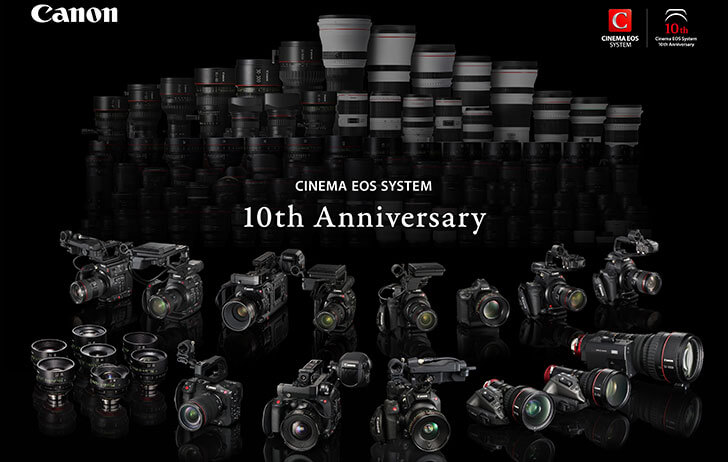Canon is celebrating the 10 year anniversary of the Cinema EOS system. It was announced ahead of NAB 2011 with the introduction of the Canon Cinema EOS C300, Canon Cinema EOS C500 and the Canon EOS-1D C along with new Canon CN-E lenses.
The system has had some ups and downs over the last decade, but I think Canon has figured the system out and will continue to put significant resources into new camera types and lenses.
I expect to see 8K versions of the Canon Cinema EOS C300 and Canon Cinema EOS C500 lines as well as new RF mount cinema cameras along with RF versions of the Sumire series of prime lenses.
NAB 2021 was supposed to be last month, but it was cancelled due to the ongoing pandemic. NAB is scheduled to take place in April of 2022. We may not see significant Cinema EOS until later in Q1 of 2022.
Press Release
MELVILLE, NY, November 4, 2021 – Canon Inc. announced today that the company is celebrating the tenth anniversary of its Cinema EOS System of professional digital cinema camera and lens products for the film and visual production industries. Since its debut, the company’s line of products has received an abundance of support from professional filmmakers around the world.
In 2011, both film-analog and digital equipment were being used side-by-side in the cinema production industry. Digitalization was continuing its spread, and digital cameras equipped with Super 35mm equivalent large-format sensors were becoming the mainstay of the industry. Amid this environment, Canon leveraged its visual technologies, including the optical technologies cultivated since its founding, and launched its Cinema EOS System, thus formally marking its entry into the cinema production industry.
When developing equipment such as cameras and lenses for the cinema production market, it’s essential to have assistance from professionals in the field who use the equipment. From the release of its first digital cinema cameras (EOS C300 / EOS C300 PL) and lenses (CN-E14.5-60mm T 2.6 L S / CN-E14.5-60mm T 2.6 L SP) in January 2012, Canon has always sought out feedback about performance, ease-of-use and recording styles from end-users on the front lines of cinema production. Canon strives to develop products with designs and intuitive ergonomics that enable the shooting styles and visual expression demanded by professionals.
Canon has continued to expand the boundaries of visual expression and pursue the development of devices with ever-evolving technology. The company’s first Cinema EOS camera, the EOS C300, which is equipped with a CMOS sensor that produces video reproduction comparable to 35mm film, was awarded a Technology and Engineering Emmy® award from The National Academy of Television Arts & Sciences (NATAS) in 2012. What’s more, the company has been honored for its cinema lenses, having received another Technology and Engineering Emmy® award in 2017 for its 4K cinema lenses that have earned high praise from the market for its excellent optical performance.
Canon’s Cinema EOS System is widely used in the modern cinema production industry, including in film and television production. The EOS C300 Mark II (released in September 2015) digital cinema camera and eight cinema lenses were used to film the 2018 Academy Award-winning documentary Free Solo. The System was also honored at the Sundance Film Festival in January 2020, where the winner of the World Cinema Documentary Special Jury Award for Cinematography, ACASĂ, MY HOME, was filmed with the EOS C300 and EOS C100 Mark II cameras (released in December 2014).
Message from Hiroto Okawara, Unit Executive, Image Solutions Business Unit 2
I am truly honored to have reached this ten-year milestone. It’s thanks to the support from all of you in the cinema production industry, we’ve made it all the way here from our very first steps into Hollywood. In order to help creators produce work as close to their ideals as possible, we will continue to push forward in our efforts to further develop the Cinema EOS System.
The cinema production industry evolves day by day, and Canon will also continue to implement new technologies in order to create products that serve the ever-diversifying needs of users.
Message from David Klein, member of the American Society of Cinematographers and Cinema EOS System user
Canon still cameras and lenses have been in my hands since I was old enough to click a shutter. Canon’s cinema lenses have been in my hands for almost ten years now, and we have relied heavily on specific characteristics like their personality, sharpness, consistency, and reliability. The EOS-1D C camera has been in the arsenal since 2013, along with every flavor of EOS C300 cameras in some capacity, and they’ve all given us the images we want and need on a daily basis. So happy 10th-anniversary Cinema EOS System, we’re all looking forward to the next ten.
The Cinema EOS System Product Lineup
Launched in 2011, Canon’s Cinema EOS System leverages the company’s strengths—including the ability to develop and manufacture in-house key features such as CMOS sensors, visual processing platform, and interchangeable lenses. Today, the system’s expansive lineup comprises 13 digital cinema cameras and 30 cinema lenses*. In addition to digital cinema cameras and lenses, the system is compatible with the company’s EOS Series RF and EF lenses, helping to support a diverse range of visual expression for creators everywhere.


2 comments